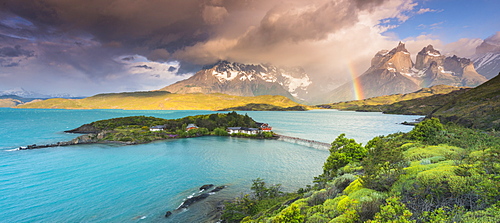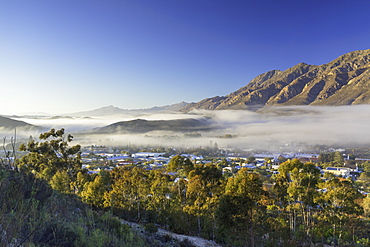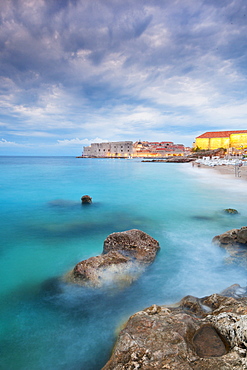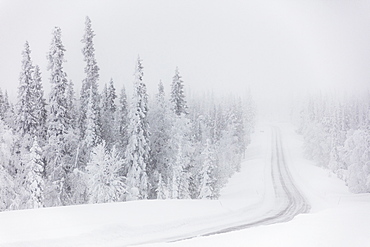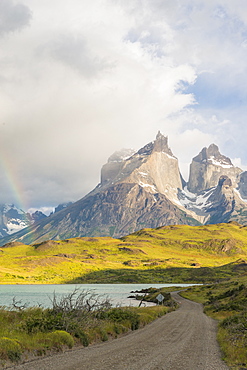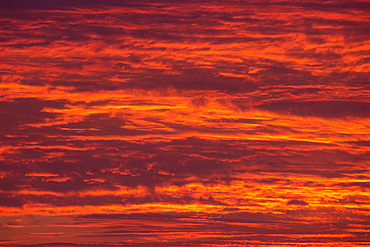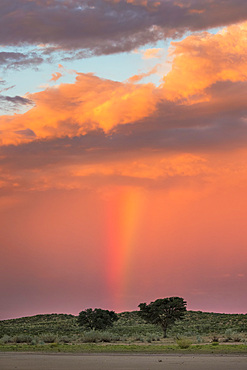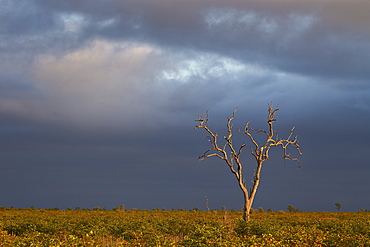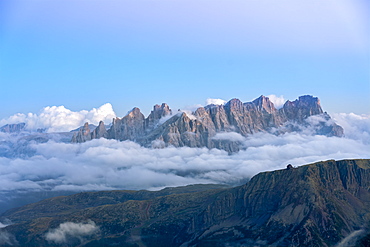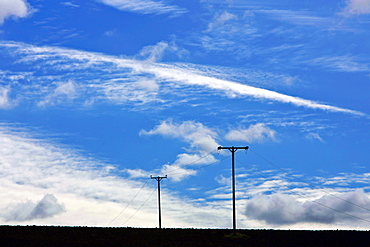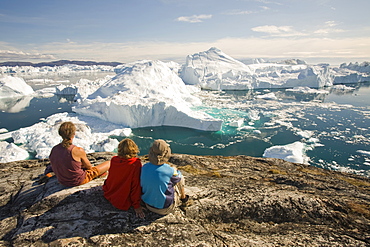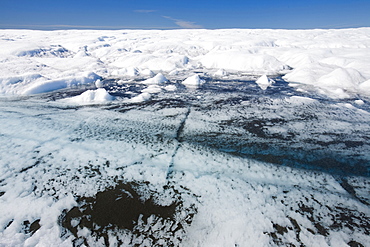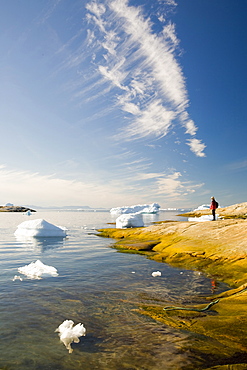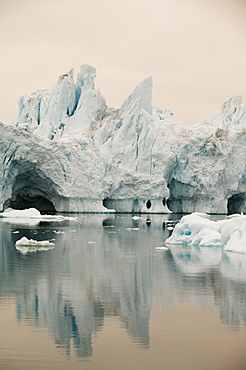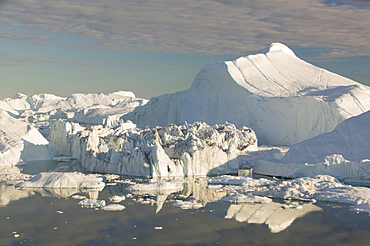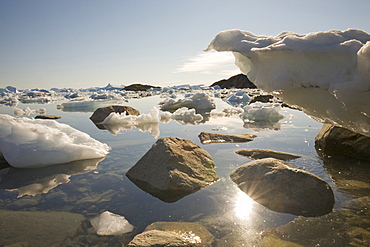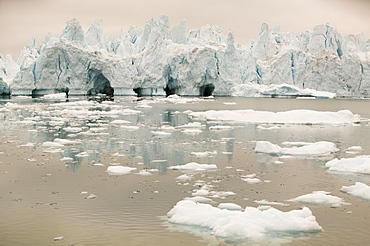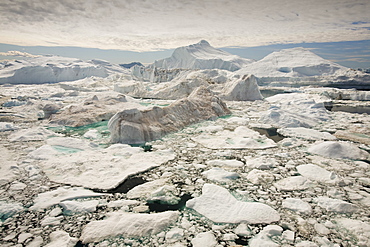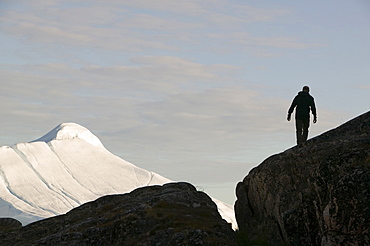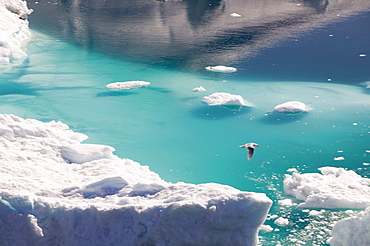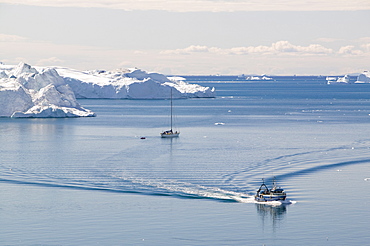Results
« Previous 1 … 3 4 5
405 results found
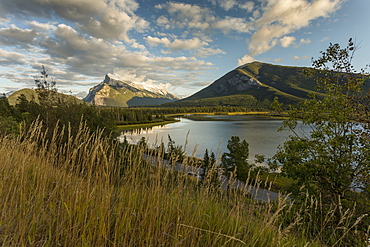
Gathering winter storm, Banff National Park, UNESCO World Heritage Site, Canadian Rockies, Alberta, Canada, North America
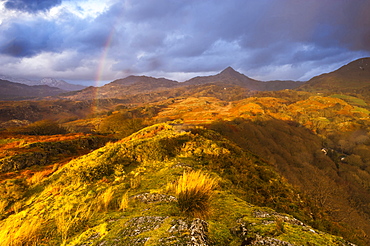
Cnicht under a rainbow at sunset, Snowdonia National Park, North Wales, Wales, United Kingdom, Europe
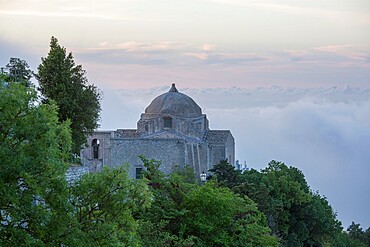
The hilltop Church of San Giovanni Battista, low cloud obscuring the landscape beyond, Erice, Trapani, Sicily, Italy, Mediterranean, Europe

Upturned weathered boat hut with Lindisfarne Castle and fishing boats at low tide, Holy Island, Northumberland Coast, England, United Kingdom, Europe
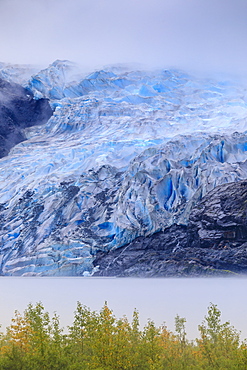
Bright blue ice of Mendenhall Glacier flowing from Juneau Ice Field, mist on Mendenhall Lake, Juneau, Alaska, United States of America, North America

High winds and heavy seas on approach to the New Island Nature Reserve, Falkland Islands, South America
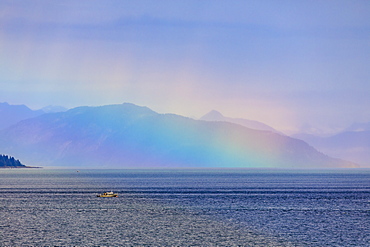
Boat, huge rainbow colours light up mist over the Fairweather Range, Icy Strait, near Glacier Bay, Inside Passage, Alaska, United States of America, North America

Cotswold landscape with sheep, Chipping Campden, Cotswolds, Gloucestershire, England, United Kingdom, Europe
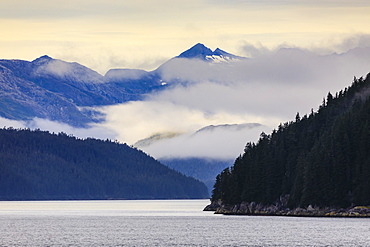
Mist over the Fairweather Range, Icy Strait, between Chichagof Island and Glacier Bay National Park, UNESCO World Heritage Site, Inside Passage, Alaska, United States of America, North America

Uluru (Ayers Rock), Uluru-Kata Tjuta National Park, UNESCO World Heritage Site, Northern Territory, Australia, Pacific
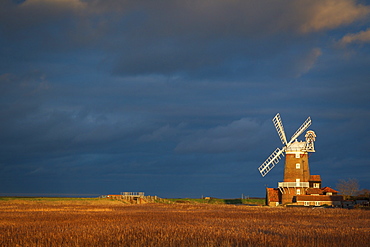
Storm clouds move in over the reedbeds towards Cley Windmill at Cley Next the Sea, Norfolk, England, United Kingdom, Europe

View of Chicago skyline and rainbow from North Shore, Chicago, Illinois, United States of America, North America

People on Rialto Bridge with umbrellas during rare snowfall, winter evening, Venice, UNESCO World Heritage Site, Veneto, Italy, Europe

People in shopping street with umbrellas during rare snowfall, winter evening, Venice, UNESCO World Heritage Site, Veneto, Italy, Europe
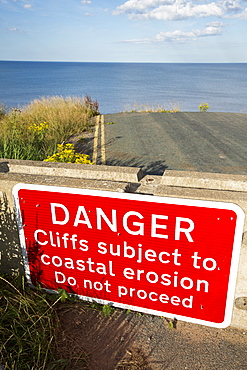
A collapsed coastal road near Skipsea on Yorkshires East Coast, UK. The coast is composed of soft boulder clays, very vulnerable to coastal erosion. This sectiion of coast has been eroding since Roman times, with many villages having disappeared into the sea, and is the fastest eroding coast in Europe. Climate change is speeding up the erosion, with sea level rise, increased stormy weather and increased heavy rainfall events, all playing their part.
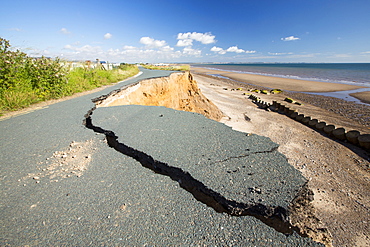
A collapsed coastal road at between Skipsea and Ulrome on Yorkshires East Coast, near Skipsea, UK. The coast is composed of soft boulder clays, very vulnerable to coastal erosion. This sectiion of coast has been eroding since Roman times, with many villages having disappeared into the sea, and is the fastest eroding coast in Europe. Climate change is speeding up the erosion, with sea level rise, increased stormy weather and increased heavy rainfall events, all palying their part.
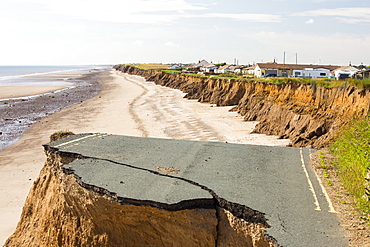
A collapsed coastal road at between Skipsea and Ulrome on Yorkshires East Coast, near Skipsea, UK. The coast is composed of soft boulder clays, very vulnerable to coastal erosion. This sectiion of coast has been eroding since Roman times, with many villages having disappeared into the sea, and is the fastest eroding coast in Europe. Climate change is speeding up the erosion, with sea level rise, increased stormy weather and increased heavy rainfall events, all palying their part.
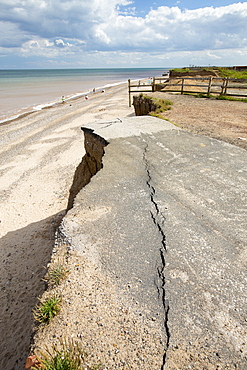
A collapsed coastal road at Easingotn on Yorkshires East Coast, near Skipsea, UK. The coast is composed of soft boulder clays, very vulnerable to coastal erosion. This sectiion of coast has been eroding since Roman times, with many villages having disappeared into the sea, and is the fastest eroding coast in Europe. Climate change is speeding up the erosion, with sea level rise, increased stormy weather and increased heavy rainfall events, all palying their part.
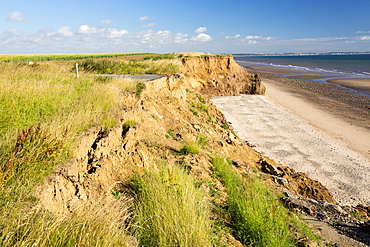
A collapsed coastal road at near Aldbrough on Yorkshires East Coast, near Skipsea, UK. The coast is composed of soft boulder clays, very vulnerable to coastal erosion. This sectiion of coast has been eroding since Roman times, with many villages having disappeared into the sea, and is the fastest eroding coast in Europe. Climate change is speeding up the erosion, with sea level rise, increased stormy weather and increased heavy rainfall events, all palying their part.

Concrete sea defences at Beach Bank Caravan Park in Ulrome near Skipsea on Yorkshires East Coast, UK. The coast is composed of soft boulder clays, very vulnerable to coastal erosion. This section of coast has been eroding since Roman times, with many villages having disappeared into the sea, and is the fastest eroding coast in Europe. Climate change is speeding up the erosion, with sea level rise, increased stormy weather and increased heavy rainfall events, all playing their part.
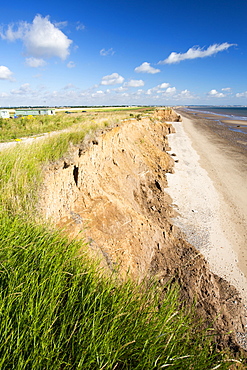
A collapsed coastal road at between Skipsea and Ulrome on Yorkshires East Coast, near Skipsea, UK. The coast is composed of soft boulder clays, very vulnerable to coastal erosion. This sectiion of coast has been eroding since Roman times, with many villages having disappeared into the sea, and is the fastest eroding coast in Europe. Climate change is speeding up the erosion, with sea level rise, increased stormy weather and increased heavy rainfall events, all palying their part.
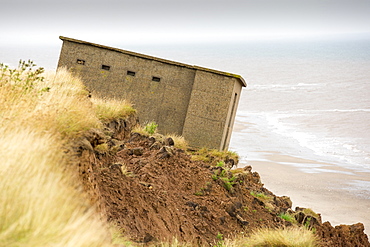
A Second world War lookout post leaning alarmingly and about to tumble over the edge of the cliff near Aldbrough on Yorkshires East Coast, UK. The coast is composed of soft boulder clays, very vulnerable to coastal erosion. This section of coast has been eroding since Roman times, with many villages having disappeared into the sea, and is the fastest eroding coast in Europe. Climate change is speeding up the erosion, with sea level rise, increased stormy weather and increased heavy rainfall events, all playing their part.
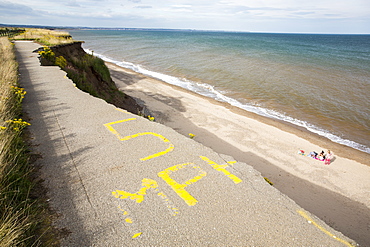
A collapsed coastal road at Barmston on Yorkshires East Coast, near Skipsea, UK. The coast is composed of soft boulder clays, very vulnerable to coastal erosion. This sectiion of coast has been eroding since Roman times, with many villages having disappeared into the sea, and is the fastest eroding coast in Europe. Climate change is speeding up the erosion, with sea level rise, increased stormy weather and increased heavy rainfall events, all palying their part.

The Thames barrier on the River Thames in London. It was constructed to protect the capital city from storm surge flooding. Recent predictions show it will probably be redundant in around twenty years due to increased stormy weather and sea level rise driven by climate change.

The Thames barrier on the River Thames in London. It was constructed to protect the capital city from storm surge flooding. Recent predictions show it will probably be redundant in around twenty years due to increased stormy weather and sea level rise driven by climate change.
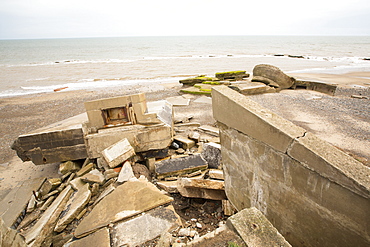
The Remains of the Godwin battery on the beach at Kilnsea at the head of Spurn point on Yorkshires East Coast, UK. Initially constructed during the First World War, the Godwin Battery was added to during the Second World War. It comprised of gun emplacements, search light, barracks, officers’ mess, and a hospital. This section of coastline is the fastest eroding coastline in Europe. The soft boulder clay cliffs are easily eroded and have been eroding since Roman Times, but recently the climate change impacts of increased stormy weather, increased heavy rainfall events and sea level rise have accelerated the rate of erosion. The average rate of attrition is 1.5metres per year, last year it was 5 metres.
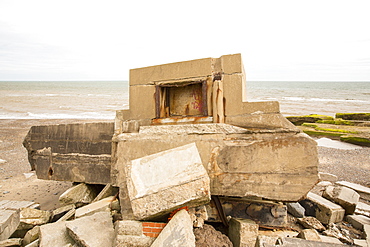
The Remains of the Godwin battery on the beach at Kilnsea at the head of Spurn point on Yorkshires East Coast, UK. Initially constructed during the First World War, the Godwin Battery was added to during the Second World War. It comprised of gun emplacements, search light, barracks, officers’ mess, and a hospital. This section of coastline is the fastest eroding coastline in Europe. The soft boulder clay cliffs are easily eroded and have been eroding since Roman Times, but recently the climate change impacts of increased stormy weather, increased heavy rainfall events and sea level rise have accelerated the rate of erosion. The average rate of attrition is 1.5metres per year, last year it was 5 metres.

The Thames barrier on the River Thames in London. It was constructed to protect the capital city from storm surge flooding. Recent predictions show it will probably be redundant in around twenty years due to increased stormy weather and sea level rise driven by climate change.
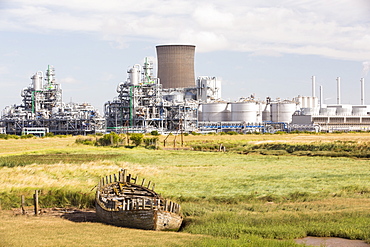
A BP chemical plant at salt End on Humberside which produces Acetic Acid and a gas fired power station It is vulnerable to coastal flooding, and although sea defences were constructed some years ago, climate change driven sea level rise and increased stromy weather, leaves it vulnerable to inundation.
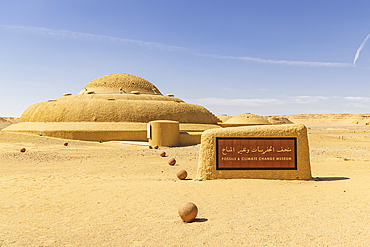
Wadi al Hitan, Faiyum, Egypt. February 20, 2022. Fossil and climate change museum at Wadi el-Hitan paleontological site.
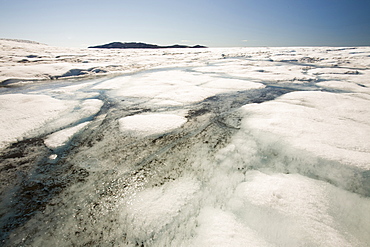
Melt water on the Greenland ice sheet which is melting at an unprecedented rate due to human-induced climate change, near Camp Victor north of Ilulissat, Greenland, Polar Regions
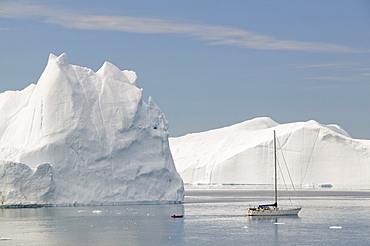
A French film crew documenting the effects of climate change sails their boat through icebergs from the Jacobshavn glacier (Sermeq Kujalleq), Greenland, Polar Regions
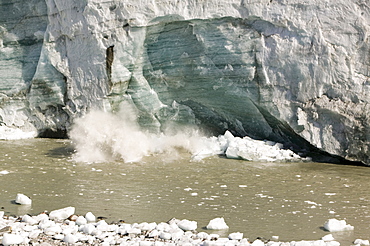
The Russell Glacier draining the Greenland icesheet inland from Kangerlussuaq on Greenlands west coast, Greenland, Polar Regions

The snout of the Eqip Sermia glacier at Camp Victor north of Ilulissat on Greenland's west coast, Polar Regions

The Russell Glacier draining the Greenland icesheet inland from Kangerlussuaq on Greenlands west coast, Greenland, Polar Regions

The Russell Glacier draining the Greenland icesheet inland from Kangerlussuaq on Greenland's west coast, Greenland, Polar Regions
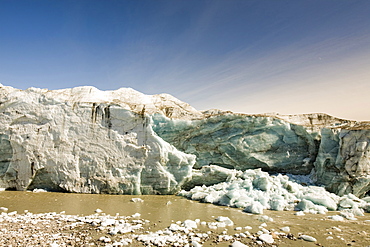
The Russell Glacier draining the Greenland icesheet inland from Kangerlussuaq on Greenland's west coast, Greenland, Polar Regions

The Russell Glacier draining the Greenland icesheet inland from Kangerlussuaq on Greenland's west coast, Greenland, Polar Regions

The Russell Glacier draining the Greenland icesheet inland from Kangerlussuaq on Greenlands west coast, Greenland, Polar Regions
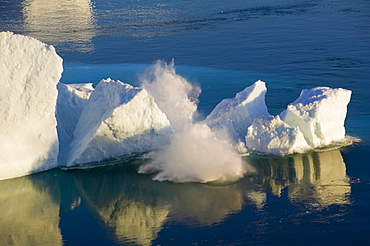
An arched iceberg collapsing into the sea from the Jacobshavn Glacier (Sermeq Kujalleq), Greenland, Polar Regions
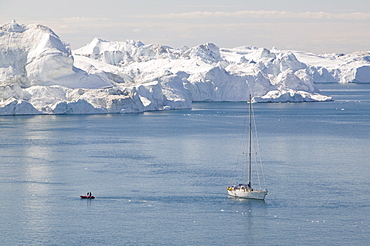
A French film crew documenting the effects of climate change sails their boat through icebergs from the Jacobshavn glacier (Sermeq Kujalleq), Greenland, Polar Regions

The Russell Glacier draining the Greenland icesheet inland from Kangerlussuaq on Greenland's west coast, Greenland, Polar Regions
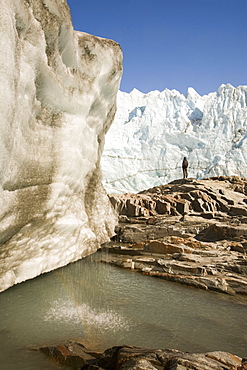
The Russell Glacier draining the Greenland icesheet inland from Kangerlussuaq on the west coast of Greenland, Polar Regions

The Russell Glacier draining the Greenland icesheet inland from Kangerlussuaq on Greenlands west coast, Greenland, Polar Regions
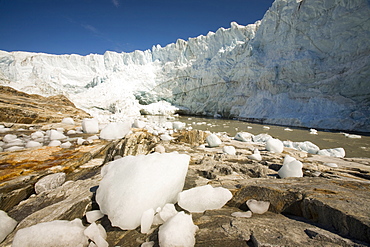
The Russell Glacier draining the Greenland icesheet inland from Kangerlussuaq on Greenland's west coast, Greenland, Polar Regions

The Russell Glacier draining the Greenland icesheet inland from Kangerlussuaq on Greenland's west coast, Greenland, Polar Regions
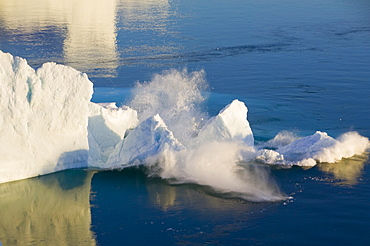
An arched iceberg collapsing into the sea from the Jacobshavn Glacier (Sermeq Kujalleq), Greenland, Polar Regions
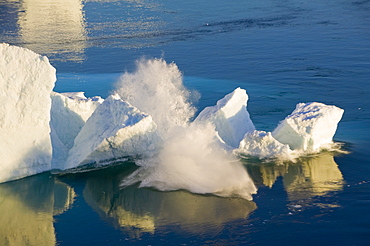
An arched iceberg collapsing into the sea from the Jacobshavn Glacier (Sermeq Kujalleq), Greenland, Polar Regions

The Russell Glacier draining the Greenland icesheet inland from Kangerlussuaq on Greenland's west coast, Greenland, Polar Regions
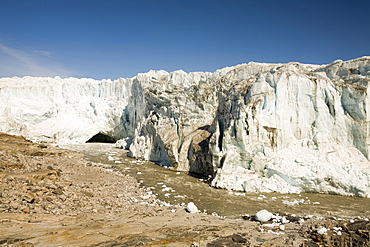
The Russell Glacier draining the Greenland icesheet inland from Kangerlussuaq on Greenland's west coast, Greenland, Polar Regions
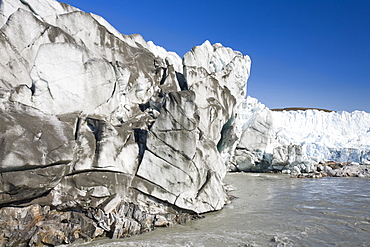
The Russell Glacier draining the Greenland icesheet inland from Kangerlussuaq on Greenland's west coast, Greenland, Polar Regions
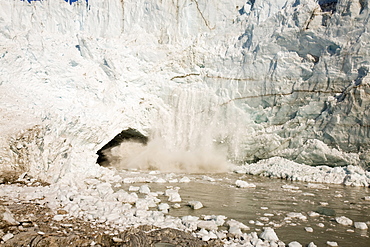
The Russell Glacier draining the Greenland icesheet inland from Kangerlussuaq on Greenland's west coast, Greenland, Polar Regions
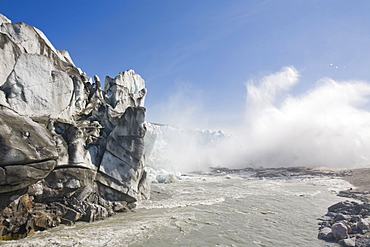
The Russell Glacier draining the Greenland icesheet inland from Kangerlussuaq on Greenland's west coast, Greenland, Polar Regions

The Russell Glacier draining the Greenland icesheet inland from Kangerlussuaq on Greenland's west coast, Greenland, Polar Regions

